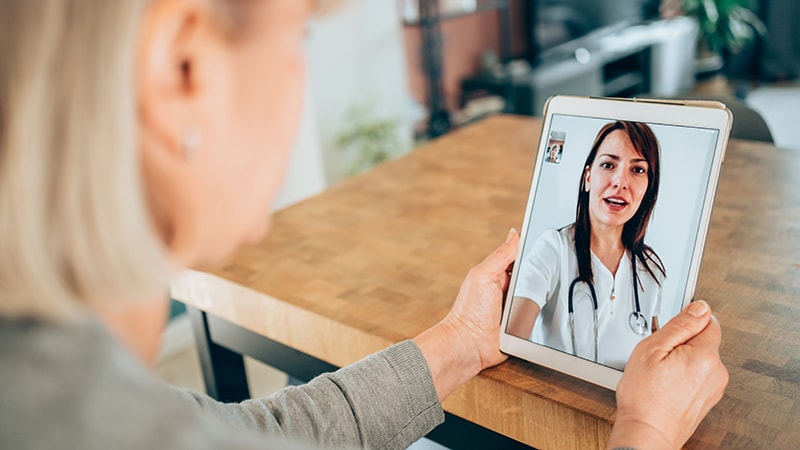Remote patient monitoring is here to stay.
Telemonitoring claims for Medicare beneficiaries increased sixfold between 2018 and 2021, in part due to relaxed COVID-19 pandemic rules. By one estimate, more than 60 million people in the United States will exchange remotely collected health data with a medical provider in 2024.
Use cases are expanding. Psychiatrists can analyze a patient’s sleep habits and reports of their state of mind between sessions. Physical therapists can use information on patient walking speed to decide whether to modify their exercise routine. Meanwhile, nurses are becoming leaders in analyzing such data generated by a patient over the course of their day.
And increasingly, research is showing technology like physiological measurements taken at home can improve the health outcomes of older adults with conditions like hypertension. Clinicians receiving ongoing data on fluctuations in blood pressures can intervene more quickly than waiting until an in-person appointment.
“We know remote patient monitoring is beneficial for care,” said Corey Hayes, PharmD, PhD, MPH, a health outcomes researcher at the University of Arkansas Medical Sciences in Little Rock, Arkansas, who has studied the technology’s role in reducing mortality for people with cardiovascular conditions. He noted that many clinicians are now concerned that these services are limited to patients with specific demographics.
“How do we actually get it into patient care universally?” Hayes asked, who worries that people in rural communities are being left behind.
Painting a Fuller Picture
George Luke Hartstein, MD, MBA, a psychiatry resident at Beth Israel Deaconess Medical Center (BIDMC) in Boston, Massachusetts, said that remote monitoring is useful for psychiatry.
“It’s sort of laughable to think that you as a person could communicate how you are doing over a 3-month period in 20 or 30 minutes,” Hartstein said.
Hartstein said records of how much someone sleeps per night combined with self-reports of how often they are depressed give psychiatrists a useful window into whether treatment is working between in-person appointments. BIDMC is piloting this approach now, using an app called mindLAMP.
The use of this technology by health providers has grown in part due to the creation in 2022 of billing codes for remote monitoring of patients receiving cognitive behavioral therapy by the US Centers for Medicare and Medicaid Services (CMS). The billing language enables support staff to fulfill the triage role Hartstein envisions, although the agency has not clarified which devices and software are eligible for reimbursement.
Physical therapists at the Mount Sinai Health System in New York City use the app OneStep for patients recovering from knee or hip replacement surgery to monitor their gait and recovery and might suggest changes to their exercise routines based on these data.
“These tools can flag indicators of increased risk of falls,” which is especially important among people older than 60, said Gabriela Rozanski, PhD, a physical therapist at the institution.
Neurologists could eventually partner with physical therapists at the health system to develop joint care plans for people recovering from strokes, Rozanski said, relying on telemonitoring to gather data on blood pressure and gait.
Emerging evidence has started to back these examples of telemonitoring use. In 2023, Hayes and colleagues compared the experience of people older than 65 who had hypertension and used a remote monitoring device with that of those who did not. Over 6 months, the patients receiving telemonitoring were less likely to die compared with the control group. They were also less likely to go to the hospital because of cardiovascular troubles.
And physicians are not the only providers responsible for making treatment decisions based on remote data.
Patients can choose to upload remotely collected data to their electronic medical records, and increasingly, nurses are charged with guiding patients to appropriate care, said Mary Anne Schultz, PhD, MSN, MBA, a professor of nursing at California State University, San Bernardino.
“Nurses are in charge of remote patient monitoring in the home,” Schultz said.
If any patient data are concerning, a nurse would use their knowledge of pathophysiology to counsel the patient. Or, they could make appropriate referrals if a change in treatment may be needed, according to Schultz, who has studied how nurses interact with remote patient data.
No Patient Left Behind
But as remote monitoring becomes more routine, equity concerns are coming to the forefront.
“The urban uptake is so much more, and rural is definitely being left behind,” Hayes said.
Hartstein noted that some patients will need more than help than others in learning to use remote monitoring tools. CMS regulations allow billing, but only for up to 20 minutes of effort, no matter how long the support lasted. Some clinicians may decide not to offer onboarding support, which could harm access for some patients, Hartstein noted.
He hopes such growing pains are resolved because psychiatrists can prevent crises with remote data.
“If you’re someone who’s experiencing mania, you may only present for psychiatric care when your symptoms have gotten quite severe,” Hartstein said. “There’s oftentimes a window of missed opportunity prior to that point at which an intervention would have been helpful.”
Marcus A. Banks, MA, is a journalist based in New York City who covers health news with a focus on new cancer research. His work appears in Medscape Medical News, Cancer Today, The Scientist, Gastroenterology & Endoscopy News, Slate, TCTMD, and Spectrum.
Source link : https://www.medscape.com/viewarticle/remote-patient-monitoring-increasingly-common-after-pandemic-2024a10003gc?src=rss
Author :
Publish date : 2024-02-21 07:35:27
Copyright for syndicated content belongs to the linked Source.
